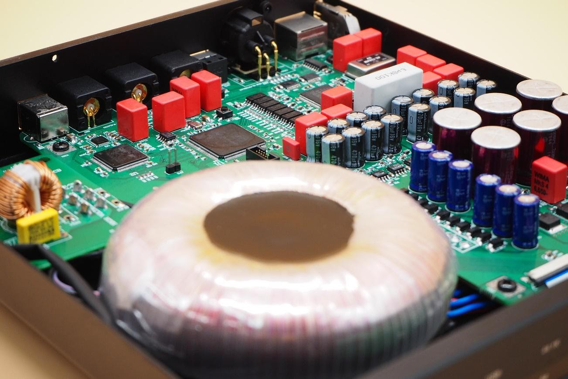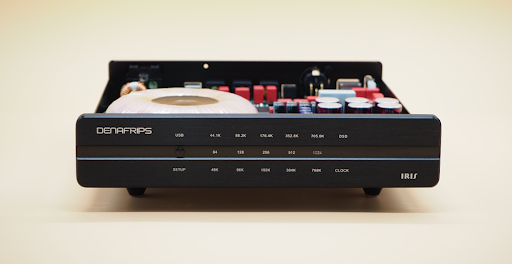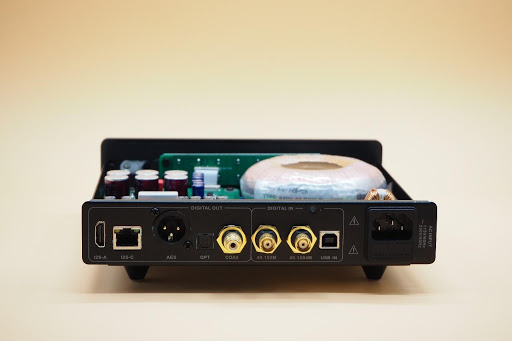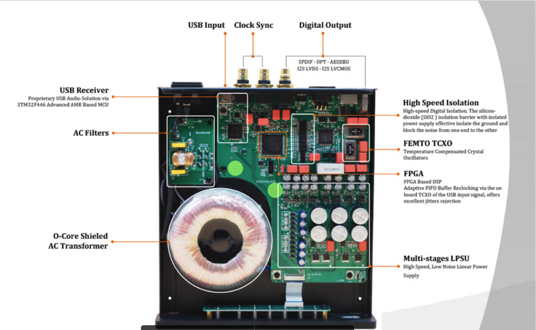I had concluded my review of the Denafrips Pontus II DAC and was getting ready to return the unit when Denafrips distributor, Alvin Chee, contacted me and asked if I would like to try the company’s IRIS DDC while I had the Pontus II on hand. Since I was intrigued by IRIS’s price point and its ability to output an I2S signal, I agreed to spend some time with it. So here’s what I discovered.

Denafrips introduced the IRIS DDC in June of 2020 after three years of development. The DDC draws on lessons learned while designing the company’s flagship DAC, the Terminator-Plus. Denafrips offers three models in their DDC lineup, the entry-level IRIS, the mid-level Hermes, and the Gaia, their flagship. The two models above the IRIS offer more varied inputs and outputs and higher precision clocks among other enhancements.
What is the IRIS DDC?
You can best understand the idea behind any DDC (Digital-to-Digital Converter) if you think of it as a “cleaner or scrubber” for a digital signal. While that is simplistic, it does get to the heart of what a DDC is trying to accomplish. For the IRIS, Denafrips uses proprietary FPGA DSP Processing, a FIFO Buffer & Reclocking, and a USB Audio Interface Solution via STM32F466 Advanced AMR based MCU to clean the digital signal and reduce jitter and noise.
The unit sends the “cleaned” output to your DAC. The new source signal with lower jitter and noise should, in theory, improve the sound of the DAC by removing spurious noise and artifacts from the source signal that
could interfere with the DAC’s accurate conversion of the signal to analog. Does all this signal cleaning improve the sound?
Early computer audio had several issues to deal with including “noise” in the USB output. Several products have been developed to address these issues. Nowadays, USB audio has come a long way with the advent of dedicated music servers sporting advanced USB outputs. Many current DACs have galvanically isolated USB inputs, asynchronous USB designs, etc.
Fundamentals of the IRIS DDC
So, do we still need a DDC that “cleans up” the digital source signal? Will it have a significant impact on the music? Before we get to its impact on the sound, let’s cover some of the fundamentals of the unit. The IRIS would qualify as a mid-sized unit being 8.6” H x 9.8” D x 1.75” H and weighing in at a solid-feeling 7.7lbs.

The front of the unit (shown in the photo above) has multiple discrete LEDs to indicate the sampling frequency of the file you are playing. SETUP is the only button on the front faceplate. It enables/disables the word clock function. There is no power on/off button. Denafrips’ use of temperature compensated FEMTO Clocks (TCXO) dictates their desire to always have the unit powered ON. For best performance, they want the FEMTO clock to reach its designed operating temperature and stay there.

On the rear of the unit, you will find a USB input that is optically isolated by 50-Mbps high-speed photocouplers. Optical isolation is said to yield a lower noise floor and achieve a higher signal-to-noise ratio. The “converted/cleaned signal” is output as S/PDIF, optical, or AES. It also sports two I2S connections, one HDMI, and one RJ45 output, and has provisions for an external clock. There is also a fused IEC power inlet.
What Is This I2S Connection About?
Ok, I hear you and I sympathize. You may be thinking that you have finally gotten a grip on S/PDIF, optical, and AES connectors and now this I2S thing comes along. What is it? The short answer is that it is simply another way to transmit digital data. Pronounced “eye-squared-ess,” Phillips Semiconductor introduced it in 1986 to transmit audio digital data INSIDE a component. If you want to dig a little deeper, here’s a link to more information I found from Phillips.
In the past few years, we have seen I2S connectors starting to appear on digital components for EXTERNAL connections. This application throws a lot of variables into the mix. I2S was designed for internal use, and there are no standards for the connector on an external cable. Hence you have I2S connections terminated with HDMI connectors, RJ45 connectors, DIN connectors, and more. To make matters worse there is no standard “pinout” on the connector. HDMI input connectors from different manufacturers may have different pin configurations. All these variables have made I2S a bit confusing. Without getting into a lot of technical detail, suffice it to say this connection protocol has advantages and disadvantages and, as with all things in audio, you should trust your ears.
Disclaimer: This is a complex subject, and I will be the first to confess I am not the person to write a dissertation on it. I included this small section to provide some information for anyone who does not know what an I2S connector is and why its form is not standard.
A Look Inside the IRIS DDC

The picture above shows the internal layout of the IRIS. Construction is first class with a focus on board layout to keep signal paths short. The design employs SMD components to reduce impedance and increase the transmission speed of the signal, and it also pays a good bit of attention to the power supply. This design filters the incoming AC power before it gets to the oversized O-core transformer. The subsequent linear power supply uses eight sets of Ultra Low Noise, Precision Linear Power Regulators.
Do Denafrips DACs need a DDC?
When Alvin Chee approached me to listen to the IRIS, the first question I asked myself was, “Isn’t this already built into the Pontus II, Venus II, Terminator, or Terminator-Plus?”
Here is his answer:
“The DDC components are meant to be paired with DENAFRIPS DACs and other DACs on the market. The DDC elements are not found in the Venus II/Terminator/Terminator-Plus.
It’s a very good question. I asked DENAFRIPS chief designer, Mr. Zhao, the same question when he planned to release the DDC. He agreed that the DAC’s USB input is already very good. However, due to the space constraint in the DAC, there is room for improvements that could not be implemented in the DAC. He designed the DDC to reclock and buffer the digital signal via its internal crystals (Temperature Compensated Crystal Oscillator TCXO for IRIS, OCXO for Hermes and Gaia). The process reduces the jitter to a negligible level. The cleansed digital signal will then output to the external DAC via coax/opt/aes/i2s effortlessly.”
Hooking Up the IRIS DDC
My Aurender server’s USB output was my source. I alternated going straight into the Pontus II DAC or sending the USB to the IRIS and routing the IRIS S/PDIF and I2S HDMI output back to the Pontus II DAC.
I also used the IRIS with my reference McCormack DAC1 Platinum. This DAC only provides for a S/PDIF input.
I used a Triode Wire Labs American 10 Power cord along with a Wire World Ultraviolet 7 HDMI for the I2S connection, and a Triode Wire Labs S/PDIF digital cable. As a USB cable, I used the excellent Triode Wire Labs Split Power & Data cable for the Aurender USB output.
I will note that I have not made the leap to DSD yet, so my report on the IRIS will not address this function.
The IRIS settled into my system for a full week of 24/7 operation. I will say that during the initial 48 hours it sounded a bit hard, but that hardness went away, and I felt the unit had stabilized on the 4th or 5th day. So don’t be too hasty to judge the sound if you try one. A run-in of 100 to 200 hours should be just fine.
I2S vs S/PDIF CONNECTION
I preferred the I2S HDMI with the Pontus II. While the S/PDIF output of the IRIS exhibited all of the improvements noted below, the I2S connection amplified those improvements on the Pontus II. Admittedly, I could have reached this conclusion as the result of several factors including the cables I used and the character of the different inputs on the Pontus II among other things. Using the IRIS with another DAC may have resulted in a different conclusion. In my experience, I2S can be very system-dependent. So, as I mentioned earlier, try all the combinations, and trust your ears.
Did the IRIS DDC Improve the Sound?
The purpose of this review was to determine if adding the IRIS DDC to the Pontus II or the DAC 1 improved the sound quality of my system. I wanted to know what changes it made in the sound and if a product in this category warranted further investigation.
Well, frankly this was one of the easier comparisons I have made in quite some time. I went back and looked at my earlier Pontus II review notes. While the sound impressed me, I noted the following areas that, in my opinion, could be addressed.
“The transparency of the leading edge of the music could be better. The notes sounded ever so slightly like they had been ‘sanded,’ like the sharp, wide open transparent edge had been smoothed just a hair.”
I went on to note, “The bass was detailed and exceptionally powerful in the range of 30-80hz. However, it lacked a bit of authority in the under 30hz range. And while the soundstage had admirable width, the depth, which was better than most digital, could be better. It lacked that ability to feel like you can look around the instrument.”
Imagine my surprise when the upgrades in sound quality that I heard with the IRIS in the signal path were in these identical areas: Soundstage, Transparency, and Bass.
Soundstage
I easily heard an improvement in the soundstage with the IRIS engaged. It was not subtle. The soundstage was expanded and there was more space between instruments and vocals. With the increase in depth and width, I get the sense that I was listening to the music in the venue and not standing at the door of the venue. Adding the IRIS to either DAC created a more holographic feel to the presentation. Instruments and vocals had more density and solidity.
Transparency
Vocal clarity improved to take on a more organic quality. Vocals feel denser and have more presence. Subtle details are more fully revealed. Transients felt faster and were more sharply focused. The leading edge “sanding effect” I referred to in my Pontus II review was significantly reduced. These improvements were the result of the IRIS revealing more information and an increase in transient speed. They were NOT the result of a “hotter” top end.
Bass
This one caught me off guard. The improvement in the bass quality was a real surprise and, frankly, not an area where I was expecting a big change. I found that with the IRIS the bass was tighter, cleaner, and went deeper. It also had a sharper attack and focus. These improvements allowed the bass to lay a foundation that the music could lock into. It was a significant improvement.
Examples of Improvements
I listened to the IRIS over a two-month timeframe, and the improvements that I noted above were quite consistent. Here are a couple of examples that enabled me to easily quantify the differences I heard.

Doug MacCleod’s Reference Recording effort, There’s A Time, features excellent recording and contains some great music. When I listened to the “Run with The Devil” track, the IRIS brought a more dimensional soundstage and a more human sound to the presentation. Doug’s voice had more body and better focus. The IRIS improved the guitar tone, dynamics, and clarity.
This is a very intimate track and midway through this cut, I could hear Doug’s foot subtlety tapping. With the IRIS the foot-tapping is quite clean with a sharp leading edge, and it is very rhythmic. Without the IRIS, the tapping sounds like there is a cloth wrapped around the shoe, and the leading edge is blunted. In short, it loses its rhythmic feeling. While this detail may seem insignificant, when you consider that the IRIS renders subtle information like this throughout the entire song, you begin to understand how the IRIS can more easily draw you into the music.
What the IRIS Brings to the Party

I am a huge fan of Allen Toussaint. Growing up in New Orleans I was fortunate to see him perform dozens of times and meet him on multiple occasions. He is a musical legend, a real gentleman, and his passing was a tremendous loss. The Bright Mississippi is one of my favorite Allen Toussaint albums. “St James Infirmary” is a track that easily highlights what the IRIS brings to the party.
With the IRIS, the soundstage is larger, deeper and the instruments are better separated. Toussaint’s piano feels more present, its tone is richer, and the harmonics are more abundant. The hand-clapping sounds throughout the song are more natural and “fleshy.”
There is one point in the song where a hand clap is quickly followed by a snap of the fingers. With the IRIS, these sounds are better resolved and clearly heard. Without the IRIS, it is harder to hear the distinction between the clap and the snap. I attribute this to the upgrade in transparency and transient speed that the IRIS brings to the party.
The improvement in the bass was substantial. Midway through the cut, a large bass drum is added to the mix and it is easy to distinguish it from the existing bassline. You can feel its power, and it is well focused. Without the IRIS, the bass drum is looser, fatter, and less defined. It is also more homogenized with the existing bassline, and they do not sound like two separate bass instruments. Listening to this cut with the IRIS took my enjoyment and understanding of the music to a higher level.
Conclusion
During my time with the IRIS, there was no question that it took the sound of the Pontus II and my McCormack DAC 1 Platinum to a higher level and the upgrade in sound quality was consistent between the two DACs.
At a current price point of $575, the IRIS DDC is an easy recommendation and another exceptional value from Denafrips. Whether you have a Denafrips DAC or another brand, I would fully expect the IRIS to take your DAC to a higher level of enjoyment.
If you are looking to kick your digital experience up a notch, a DDC is something you may want to investigate, and when you do, the Denafrips IRIS should be in the mix. I am only left wondering what sonic improvements the higher-priced Hermes and Gaia DCCs offer. I plan to investigate this and let you know.
Specifications
Description – Parameters:
AC Power: 110VAC or 240VAC
Power Consumption: < 20W
Digital Input: USB
External Clock Input: 45.1584MHz or 49.152Mhz
Digital Output: Coax SPDIF via RCA,TOSLink x 1,AES/EBU x 1
I²S HDMI LVDS Standard, I²S RJ45 LVCMOS Standard
Supported Format (DSD): DSD64 All Input
DSD64 – DSD512 USB & I²S Only
Supported Format (PCM): 24bit/44.1, 48, 88.2, 96, 176.4, 192 kHz All Input
44.1 – 768 kHz USB & I²S Only
Dimensions: 8.6” H x 9.8” D x 1.75” H
Weight 7.7lb
Associated Equipment
ANALOG SOURCE:
AMG Viella 12JT Turbo turntable /tonearm & VIV Labs Rigid Float Tonearm
Benz Micro LP-S MR cartridge & DS Audio Master One cartridge,
HANA ML Mono MC Cartridge, Denon 103R
PHONOSTAGE:
DS Audio Master 1 phono EQ, PS Audio Stellar Phono, Parasound JC3+
DIGITAL SOURCES:
Aurender S-10 server/streamer
McCormack DAC-1 Platinum, McCormack SST-1 transport, Modified McCormack Signature CD Player
OPEN REEL:
Studer A 810 with Flux Magnetic Heads optically aligned by JFR Magnetics and direct-wired into a King/Cello tape preamp
LINE STAGE:
The Truth v.3 (passive)
Luminous Audio Axiom II Walker Mod (passive)
Vinnie Rossi L2SE
POWER AMPLIFIERS:
Pass Labs SIT 3
SMC Audio DNA-1 Platinum
PS Audio M1200 monoblocks
SPEAKERS:
Acoustic Zen Crescendo II
Pure Audio Project Treo 15 Classic
CABLES:
Acoustic Zen
Audience
Triode Wire Labs
ASI Liveline
Analysis Plus
A/C POWER:
Dedicated 20 amp lines
Audioquest Niagara 5000
P.I. Audio UberBUSS
Outlets from Audience, Jena Labs, P.I. Audio.
ACCESSORIES:
SMc Audio UFO Isolation Base,
Stillpoints Ultras, Apertures & LPI
VPI Bricks
Cardas Myrtle Blocks
DS Audio ION-001


“I am only left wondering what sonic improvements the higher-priced Hermes and Gaia DCCs offer. I plan to investigate this and let you know.”
I
Thanks for the review. I would like the ability to have more inputs than the IRIS offers, so I am interested in the Hermes ( actually the GAIA, to go with my silver Pontus II. However, It would already be a stretch for the cost of the Hermes, so I’ll forget the GAIA. 🙂 )
Are you still planning on doing a review of the Hermes? If so, when?
Do I need to email Alvin to ask to send you one? 🙂
Thanks for listening.
Scott
Hey Scott,
I hope you are enjoying your Pontus II DAC. I will be investigating the GAIA in the Spring of ’22.
Thanks for reading The Beatnik!
Ken, I could not agree more with your review impressions. I have the Iris feeding the Pontus II via I2S and the Ares II via optical. They run my main and office systems.
I can hear the difference the Iris makes in both rigs. They are fed by a Beelink PC USB AQ cable. The main has the Pontus II going to a Willsenton R8 tube amp and Klipsch Forte IV speakers. The secondary rig has the Ares II going to a Burson Funk amp and Klipsch Synergy Black Label B-200 speakers.
All cabling is AQ tapping into a PS Audio P15 regenerator. Interconnects are AQ Waters and Earths, with speakers cables being Robin Hood Zeros and Castle Rocks.
I can believe folks who don’t hear the difference if they don’t have as resolving a system. I’ve tested gear components independently. Having the regenerator providing clean power and good autobahn-grade cabling carrying signals I know is necessary to appreciate all that the Denafrips gear has to offer and unlock the full potential of all the components.
I have not upgraded the optical cable and HDMI to AQ but I will in the future. It’s hard to imagine further improvements but who knows. The joy of discovery is part of what this hobby is about.
Thanks for the music recommendations. Awesome!
Aramndo,
Glad you enjoyed the review and the music recommendations.
I really enjoyed my time with the Pontus II/ Iris combo and I hope to explore the Gaia in the Spring.
That Willsenton/Forte IV match up you have sure sounds like a lot of fun!
Keep listening !
and thanks for reading The Audio Beatnik…Ken
Armando I have an Ares ii…in your opinion should I consider the iris even though the ares ii doesn’t have i2s?
Hi Ken,
Great review. I’ve just discovered Vinshine’s stuff while perusing the new DAC offerings and reviews around the web(just missed the price increase too). Great value products. I still love my old PS Audio DLink III, can’t really afford a high-end replacement yet(looking at the Ares II or maybe Pontus). I’m wondering what improvement the Iris would have over the Peachtree X1(USB powered) USB to SPDIF converter/isolator/re-clocker that I’m currently using to feed the PS Audio DAC. I’m guessing overall jitter of the re-clocking circuits and power supply might be the differences, as well as optical isolation(Ares) vs pulse generator isolation(Peachtree) for the coax output. Thanks for any thoughts or ideas.
I have the Iris and the sound is simply as putting a blanket on my speakers.
I tried with Pontus and other dacs and this is very bad.
Boring sound, lack of details and boring.
The bass is a bit better but this product is a waste of money.
I use Denafrips Preamp and Denafrips Amplifier and they are very good.
Greetings Ilan
Thanks for reading The Audio Beatnik and offering your listening comments about the Iris in your system. Difference reactions to audio components are not uncommon in our hobby and I respect the conclusions you came to that it did not blend well with your system. I am sorry to hear your experience differed from the majority of people I have heard back from that liked the impact the Iris had in their system. As always, in the end, it is about what works for you.
Keep listening and enjoying the music.. -Ken